CLOUDY DAY REFLECTIONS
Elisa Hendrey of Sound Beach snapped this surreal photo at Mt. Sinai Harbor on March 19 using her iPhone 6.
Send your Photo of the Week to [email protected]
CLOUDY DAY REFLECTIONS
Elisa Hendrey of Sound Beach snapped this surreal photo at Mt. Sinai Harbor on March 19 using her iPhone 6.
Send your Photo of the Week to [email protected]
By Melissa Arnold
As most businesses come to a standstill to aid in social distancing, many people are looking for ways to help their neighbors and community. While there’s plenty to do for one another, local wildlife organizations have their own plea: Don’t forget the animals.
It’s a tough time for places like the Save the Animals Rescue (STAR) Foundation in Middle Island, a non-profit which rescues and rehabilitates a wide variety of injured wildlife. They also provide a place of sanctuary for those animals not well enough to return to their natural habitats.
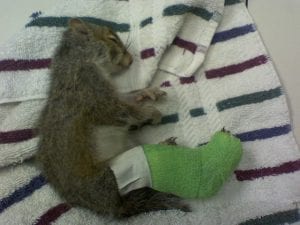
“We rescue those unusual pets that people have abandoned, birds and reptiles, guinea pigs, rabbits, and we’ve been doing this for 25 years,” said STAR Foundation co-director Lori Ketcham. “We are 100 percent reliant on volunteers, and have no paid staff or municipal support. [Normally] about 30 hands-on volunteers assist with rescues, provide animal care, clean cages, help with transport and do whatever else we need help with.”
The STAR Foundation has a long-standing relationship with the Animal Emergency Service clinic in Selden. Temporary limits on staffing and social distancing measures have added additional pressure to the clinic, and for now, STAR is no longer able to send animals to them for immediate care.
“They’re short on equipment and supplies, and what can they do? We [in the animal care field] need gloves and masks just like every other profession, and when those things are gone, they’re gone,” Ketcham said. “And while we’d happily welcome vets who are willing to provide care, not every vet is certified to work with wild animals, so we can’t turn to just anyone.”
The warmest months of the year are also the busiest times for animal rescue organizations, between the arrival of new baby animals and those that sustain injuries while out and about. STAR cares for about 150 animals at a time — currently they’re bottle-feeding baby squirrels and rabbits, caring for woodchucks and all kinds of birds, from quail to great horned owls, and small exotic pets with nowhere to go thanks to suspended adoptions.
While the foundation is keeping a skeleton crew of two to three people on-site, sanitizing regularly and staying separated as much as possible, each new person that enters the building resets that process and introduces new risks, Ketcham explained.
At Sweetbriar Nature Center in Smithtown, they have the same concerns.
“It’s certainly a big challenge for us — since we’ve been closed to the public, we have only one or two people coming in to work,” said Sweetbriar’s education director Eric Young. “Volunteers have taken some of the animals home for care, but that’s only temporary.”

The center is home to countless animals of all kinds, from bustling ant colonies and hissing cockroaches to box turtles and groundhogs, the occasional goats and foxes, to name a few. Young estimates there are around 50 different kinds of animals on site. At the moment, its on-site Wildlife Rehabilitation Center is caring for several owls and rabbits, a hawk that suffered a gunshot wound, gulls and Canada geese, among others.
As education director, Young said he’s feeling the loss of the many students who visit the center at this time of year. Sweetbriar interacts with thousands of students annually, including in-school presentations and class field trips.
Now, with schools closed and students adjusting to digital learning in varied forms, Young is trying to find creative ways to bring the animals online.
“We’re thinking about sharing our animal presentations on YouTube, and I’m in the process of putting together resources to share with teachers,” he said.
At this point, Director of Wildlife Rehabilitation Janine Bendicksen is simply hoping for a quick end to the pandemic so that they can ensure the wellbeing of the staff.
“The Town of Smithtown covers our utilities and major repairs, but we still depend on financial support to pay the salaries of our staff, care for the animals and purchase formula, medicine and food,” Bendicksen said. “Our greatest need right now is to continue to support our staff.”
Ketcham echoed the need for continued donations in these difficult times.
“We plan our fundraisers well in advance, and without doing five or six fundraisers a year, we’re not going to make it,” she said. “We don’t know what events we will be able to hold. Everything is up in the air right now. It costs about $8,000 a month to keep the center going, and donations have slowed to a trickle. We have utility bills and insurances, cleaning, food and medical supply bills, no matter what else is going on. Without programs or fundraisers, it will become critical in no time.”
Both the STAR Foundation and Sweetbriar Nature Center are encouraging those who wish to support them with donations to send money only at this time — please protect the staff and do not bring supplies to their physical locations.
To donate to the Save the Animals Rescue (STAR) Foundation, visit www.savetheanimalsrescue.org. Call 631-736-8207 for urgent assistance with wildlife.
To donate to Sweetbriar Nature Center, visit www.sweetbriarnc.org. For those who find an injured wild animal, call 631-979-6344 and leave a message.” All our phone calls go directly to an answering machine that we check each day, we will call them back and give advice. We will accept wildlife if possible,” said Bendicksen.
You can also visit the Department of Environmental Conservation website at www.dec.ny.gov and search for “wildlife rehabilitator near me” to connect with other rescue organizations in your area.
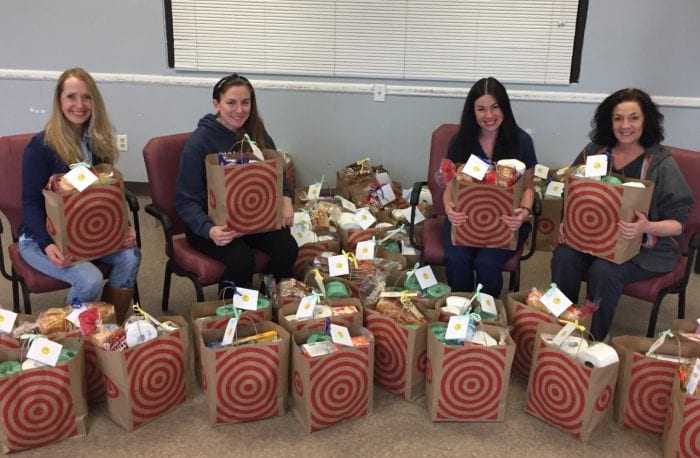
During these days of self-quarantining and social distancing, three Huntington-area women are working together to ensure local seniors have what they need.
With health care professionals and elected officials recommending the elderly stay home during the novel coronavirus pandemic, Erin Whelan, Amanda McCrea and Kristin O’Leary decided they needed to do something for the community’s senior members. Whelan, a phlebotomist/accessioner at Huntington Hospital who lives in Northport, said during a phone interview she reached out to the Town of Huntington’s director of Senior Division, Julia Frangione, to see what was needed and offered to make care packages with her friends for those who receive services from the facility.
“We noticed a lot of elderly people looking very lost in the supermarkets with empty shelves and chaos,” Whelan said.
McCrea added that with shoppers needing to visit multiple stores to get everything on their lists, they realized shopping had become a chore for many.
In the last couple of weeks, the women have been busy creating care packages with essentials such as toilet paper, wipes, bread or English muffins, coffee or tea, oatmeal, cookies and more. They have even added things like crossword puzzles to keep recipients entertained.
“We attached a personal note on each one just to let them know their community is thinking of them,” Whelan said. “We’re all in this together.
Putting together essentials for those in need is nothing new for the three women, who for the last few years have worked together filling backpacks with school supplies and donating them to the Family Service League in Huntington.
McCrea, who also works in Huntington Hospital’s laboratory, said it was Whelan who came up with the idea.
“I can’t ever say ‘no’ to her ideas,” she said. “Who doesn’t want to do good things and feel good?”
The women said that in order to get the items together they had to visit multiple stores. One day they spent about seven hours hunting for items. The women have been balancing the endeavor with work, as Whelan and McCrea are considered essential employees, and O’Leary, who teaches in the Merrick school district, is working from home and teaching online.
McCrea said it’s been worthwhile making the time to pick up these essential items, despite all of them still working their full-time jobs.
“We’ve all kind of made the time, and it gives us something positive to focus on,” she said.
Whelan and McCrea said they have received help from several friends, some of whom have given their time, while others have donated money.
“It just kind of snowballed with so many people wanting to help,” Whelan said.
McCrea said one day when they only had 30 rolls of toilet paper they posted their dilemma on Facebook, and a friend sent them a message saying where they could find some. Within an hour, with others helping them, they went from 30 rolls to more than 180.
So far, each care package has cost them around $17 dollars, and they have put together 55 packs and are planning to create more. On March 23, they were able to drop off the first of the packages that filled three cars at the Huntington Senior Center.
Frangione said the carloads were welcomed.
“We were happy to distribute these bonus items to our seniors,” she said. “We were amazed when 55 overflowing bags were delivered. It was so heartwarming, it brought tears to our eyes. The next day, the bags were distributed to our seniors who were truly touched by the thoughtfulness and caring of our friends in the community.”
Approximately 350 seniors receive meals from the center, which last Tuesday began delivering all five meals for the week in one day.
Whelan said that helping the seniors has taken stress and anxiety away.
“I’m a frontline person in the hospital,” she said. “It takes a toll on you, it’s stressful. There’s anxiety. I feel that we’re all helping these seniors, and we’re protecting the community from it spreading more, but we’re also helping ourselves because it’s something positive to focus on.”
To help with their endeavors, the women have set up a Facebook fundraiser page at www.facebook.com/donate/212883923126746/.
Crisis Forces Owners to Get Creative
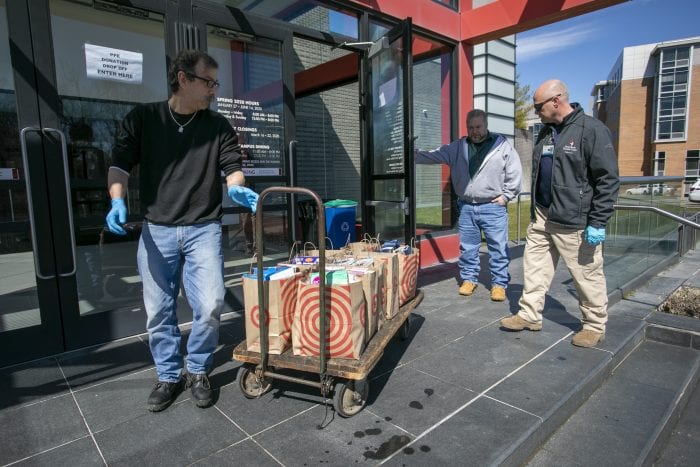
Local businesses throughout Long Island have been hit hard because of the ongoing coronavirus pandemic, but it also has brought them closer together. These uncertain times have bred creative and unique ideas in an effort to keep these storefronts afloat.

For Renee Goldfarb, owner of Origin of Era boutique in Port Jefferson, it meant finding ways to further connect with clients and new customers despite them not being able to come into the store.
“There’s not the heavy foot traffic we are used to seeing, so instead of just sitting in an empty store why not continue to interact with customers online?” she said.
Goldfarb started what she calls a “virtual shopping experience” where she showcases and models different pieces of clothing from a number of indie and female designers. In these half-hour livestreams, she said it allows customers to get that familiar experience of seeing products in real time and decide what they like.
“I’m very hands on; I want them to see how these pieces look on a normal human being, not just a store mannequin,” the boutique owner said. “The viewers also leave comments and it gives me the chance to talk to them and answer their questions.”
Goldfarb currently produces weekly videos on Instagram Live and Facebook. She said she has already sold a few items from her store and is getting good feedback from customers on the videos.
“The business community in Port Jeff is really trying to support one another,” she said.
Though times have been trying, it has not stopped local shops from supporting those who arguably need it the most.
Similarly, the Port Jefferson Business Improvement District is conducting a restaurant delivery program that will send meals to St. Charles and Mather hospitals for the medical staff, to thank them for their service during the ongoing pandemic. The Greater Port Jeff Chamber of Commerce is also assisting in the effort.
Theresa Skogen, liaison for the Port Jeff BID and the chamber, said they already started to drop off meals at the hospitals earlier last week.
“We started last Saturday — it’s been a good way to revitalize some of the businesses that had to shut down and it keeps them busy during their slower days,” she said.
James Luciano, owner of the Port Jeff Lobster House and BID secretary, said the BID is donating up to 40 meals at a time to the hospitals on a rotating basis.
“Any restaurant that is in the Greater Port Jeff area can participate,” he said. “The BID will pay them a flat fee of $500 for 40 meals. We pick up the meals and deliver them to the hospitals for free.”
Luciano said they hope to continue delivering meals every day to the local hospitals.
In addition, the Port Jeff chamber has set up a GoFundMe page to raise funds to help Port Jeff restaurants feed hospital workers at St. Charles and John T. Mather hospitals. GreaterPortJeff.com is sponsoring fundraising efforts for the restaurants involved and the campaign will also help local restaurants. As of today, close to $4,000 has been raised.
“We wanted to make sure we could provide that service, and be able to employ local personnel.”
-James Luciano
In an effort to further help Port Jeff businesses, the Village of Port Jefferson has created a website page titled Open Today. The page contains a list of over 30 restaurants and other businesses. The BID is also sponsoring a free delivery service from 12 to 8 p.m. daily.
Luciano said they wanted to have a centralized delivery system in the village during this time and at the same time have this option available to customers.
“We wanted to make sure we could provide that service, and be able to employ local personnel,” he said.
For some entrepreneurs, making sure customers know that they are still present is just as important, despite seeing a dip in business.
Gabriela Schwender, of Long Island Crafty Ones, a mobile and traveling workshop based in Rocky Point, said a lot of business plans have had to be canceled due to the pandemic. Her craft workshops cater to face-to-face interactions with her clients.
In the meantime, she has been livestreaming craft workshops on the business’ Facebook page. While she can’t provide art materials like she usually does, Schwender said she has turned to finding common household objects that can make for fun craft projects.
“Usually when I do these workshops, I’m right there to help them or guide them,” she said. “Right now, I’m answering questions through text.”
Schwender said a number of viewers have already reached out to her saying that they would like to hire her once the pandemic/shutdown is over.
Gary Pollakusky, executive director of the Rocky Point Sound Beach Chamber of Commerce, said small businesses are going through a difficult time right now, adding the chamber has reached out to all its members in an effort to assist them in any way they can, including giving each other ideas and advice.
The organization has come up with its own page titled Shop Locally, Distance Socially, which can be found on its website (www.rpsbchamber.org) where it lists a number of restaurants, retail stores and other businesses that are still open and taking online orders. The chamber is also encouraging residents to order a gift card for now, to shop with once life returns to normal.
“These small businesses and mom-and-pop shops need the support of the public more than ever before,” he said.
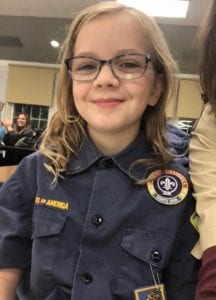
It’s been more than a year since the Boy Scouts of America became Scouts BSA, inviting girls to join separate, gender-specific units and earn the Eagle Scout rank. Since then female troop units have been popping up along the North Shore.
In the Three Village area, Setauket mom Megan Larsen recently established Troop 355. She said the number is a nod to the famous Culper Spy Ring as “355” was the code for lady. It’s believed the spies used 355 in code to refer to Anna Strong Smith who reportedly hung clothes on a line to send signals to those in the spy ring.
“It’s just a nod to our district and to our local history,” the troop leader said.
Larsen’s 13-year-old daughter Emma belonged to BSA girl unit Troop 2019 in Sound Beach when the family lived in Mount Sinai. When they moved to Setauket at the end of June, they continued with the unit, but Larsen said it was difficult to keep up with the drive with schoolwork and other activities.
Larsen said the BSA community is tight knit, and she has been receiving a lot of help from other troop leaders. Her husband, Eric, who grew up in Setauket, was involved with the local Boy Scout Troop 70 for years and was even a Venturing crew leader. He would take Emma to meetings, and when she was a toddler, she even had a Troop 70 T-shirt.
“It was sort of foreshadowing,” Megan Larsen said.
What does it take to start an all-girls BSA troop? The 355 troop leader said once a prospective leader goes to the BSA council to file paperwork and it’s approved, it’s then up to the leader to invite the community to join. On Feb. 23, she held an open house to introduce girls to the organization, and said they received a lot of help from Troop 70. Many local units, both boys and girls, also joined them in last year’s Three Village Electric Holiday Parade.
When her daughters, who include 8-year-old Audrey, showed an interest in the BSA, their mother decided to have them join. Her 10-year-old son Peter is a Cub Scout.
“I saw the positive impact that it had on my husband’s life,” she said, adding she was especially impressed with the friendships formed and public-speaking skills the boys gained.
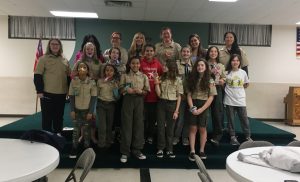
While Emma has belonged to the Girl Scouts, Larsen said Scouts BSA was a better fit for her daughter who loves whittling, kayaking and camping.
Larsen said she can understand how teenage girls may be hesitant to join something until they see their peers are a part of it.
“It’s new, and I think a lot of times girls are a little hesitant because they don’t know it’s out there, or they want to see other girls doing it first,” she said.
Troop leader Ann Colletta from Sound Beach Troop 2019 said she was on board with the idea of girls in the Scouts since it was announced. She currently has 11 girls in her unit, and she sits on the committee in her district.
“I thought it was a great idea,” she said. “I had my reservations at first because I wasn’t sure how it would work out.”
She said once she learned more about it she realized it was what her daughter June had been wanting.
Colletta said while it may seem like a leap of faith to start up a girl unit, she agreed with Larsen that other leaders, as well as boy units, have been helpful. She added when her troop originally started, it was the boys in BSA who taught the girls different skills and were welcoming and helpful.
“My girls are learning from them, and when younger girls come in the girls can teach them,” Colletta said.
The mother of seven children, who has experience with both BSA and Girl Scouts of the USA, said her 12-year-old daughter, who is also a GSA member, wanted to do the same things as her 17-year-old brother Peter, who become an Eagle Scout. Colletta said she knows what BSA can do for children as her son was shy, and she has watched him blossom.
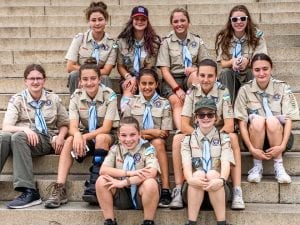
“We’re outdoor oriented,” Colletta said. “She wanted to do the same thing as him, go to summer camps and go camping.”
Craig Rome, who heads up Troop 539G in Kings Park, said he’s always willing to help other troop leaders and has found many to be helpful in spreading the word about the female units.
His girl unit, which has 17 members, will celebrate its first anniversary April 15, even though a celebration is on hold until after the current COVID-19 pandemic is over.
Like Colletta, he has found that many of the girls enjoy the outdoor activities that BSA offers. He said in addition to outdoor events, the Scouts offer community service opportunities, first-aid skills, archery and more, as well as foster leadership. Meetings are led by the Scouts themselves, and he feels it’s great to have the girls exposed to the same leadership roles as the boys, adding that young women can be part of both the BSA and GSA like his daughter Emma who started in Girl Scouts.
Since she has joined BSA, he said he has noticed a difference in his daughter, watching her now encouraged to take on leadership roles.
“I think she enjoys leadership,” he said.
Rome said that, at first, they had four or five girls, siblings of boys already in the male unit. But after putting announcements out in the school, more girls joined, and he said he thinks there was a pent-up demand. Now after seeing the impact it’s had on these children, he said he wished the BSA had done it sooner, and when people ask him if he thinks BSA works for girls, he said he finds it does.
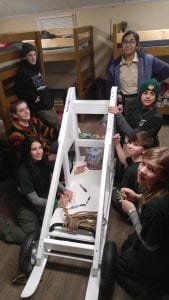
“The energy level that these girls have is incredible,” he said. “It really put a smile on your face when you saw them get together and form the troop.”
Tammy Campagnola-Levinsky has also had a positive experience as a troop leader. Since last year, 218G in Melville has grown from five to 13, and her 18-year-old daughter, Summer, who had wanted to become one since she was 7 years old is one of the Scouts.
Campagnola-Levinsky said one opportunity the girls have is an extension to become an Eagle Scout, which is also offered to the boys. Usually, a Scout must achieve the rank by 17 but an extension can be requested.
Like many girls, her daughter has become involved in activities such as camping, meeting elected officials and traveling since joining BSA, something she may not have done outside of the organization. Her daughter has also become involved in BSA’s National Youth Leadership Training.
“It’s her passion,” the troop leader said. “It’s her driving force.”
Since there’s such a lack of these all-female troops, Troop 218G has members from Nassau County and the South Shore. Rome and Campagnola-Levinsky said every Scout, whether a boy or girl, should visit different units to see how they operate since each unit can have a different style or focus. Campagnola-Levinsky pointed out that sometimes members of a Cub Scout Pack may even go on to different units.
“Scouting to me is one of the life lessons that you will take all the way through adulthood and it just doesn’t apply to scouting but your life forward — family, friends, job,” Campagnola-Levinsky said. “So, the skills you learn are lifetime skills, and you want them to be comfortable in the environment they are in and like the unit they are with.”
A Long Island couple recently did their part in the fight against the coronavirus.
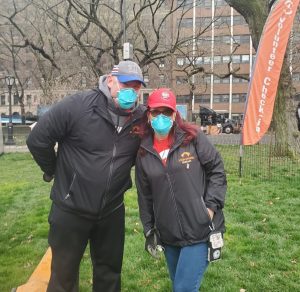
Central Islip resident Lisa Cooper, along with her husband, Shawn, joined dozens who helped to construct a field hospital for COVID-19 patients in Central Park at the end of March. Cooper said she and her husband received an email from a friend telling them how the organizers, Samaritan’s Purse, a nondenominational Christian organization that provides aid to people around the world, was looking for volunteers to pitch in and help.
The couple, who are the founders of the Long Island ministry Bridge Connection, talked over some of their concerns about traveling into the city during the pandemic, but Cooper said she started thinking about her son who is deployed overseas in Saudi Arabia, and due to her working with the National Guard Family Program, with many members now activated in New York.
“If they can stand up and be willing to serve, how do I not stand up and do my part?” she said.
The couple traveled to the city March 30 for the second day of the build. They opted not to take public transportation and drove their car. Cooper said they felt comfortable knowing they were in control of who was inside their vehicle and where they could park. It took them just over an hour to get from their home to Mount Sinai Hospital in Uptown Manhattan, and they were able to find street parking near the site directly across from the health care facility. They couldn’t help but notice how empty the streets were.
“It was not New York City on a normal Monday commute,” she said.
During the short walk to the site, they did see a few pedestrians, who seemed like health care workers, on the streets and many were wearing face masks. She said they also noticed there wasn’t anyone in the park walking or jogging like on an average day.
She said the day they arrived many of the larger tents were already erected, and only two or three more had to be assembled, though she wasn’t surprised.
“It’s a well-oiled machine how Samaritan’s Purse does things,” Cooper said, adding she volunteered with them in 2012 during Hurricane Sandy and has found the nonprofit to be dedicated and passionate with their outreach.
The Coopers were put to work right away, and the wife said she first helped to assemble cots, while her husband took part in laying down flooring outside of the tents. They also helped to lay down plywood planks across Central Park, she said, to protect the grass.
She was also able to help to unload some boxes with equipment and set up monitors along with other projects. Cooper said she was amazed that the volunteers were able to get the field hospital ready in two days, and while she had to get over some concerns about the virus, it made her feel better that patients would soon benefit from it.
“We only played a very small part,” she said. “When you think of it as a whole body, the whole body is needed to get the task done, but yet we were just such a very small part of it. I was honored that I would be asked to do that.”
Reviewed by Melissa Arnold

Every year, tens of thousands of people from around the world flee their homes. They have any number of motivations, among them political turmoil, threat of violence, discrimination and climate change, to name a few.
Retired police officer Bill Kiley has deep compassion for asylum seekers of all kinds, and recently felt a strong desire to help them in some way. Kiley, 71, of East Northport, hopes that educating children about the plight of refugees can bring about a more supportive, empathetic culture in the next generation.
His new book, “Hope and Freckles: Fleeing to a New Forest” tells the story of a white-tailed deer named Hope and her spotted fawn, Freckles, as they attempt to escape the growing number of hunters in their forest and go in search of a place where they will be safe. The sharply written story and whimsical, beautifully-illustrated characters will stir the hearts of children and adults alike.
What was your childhood like?
I was raised in Brooklyn, lived in Queens after I got married, and came to this area when I started working for the Suffolk County Police Department years ago.
Were you creative from an early age?
I wasn’t creative at all. I’m one of nine children, and we lived in an apartment with one bathroom, so you can imagine what that was like! We played a lot of sports with our friends, and I started working during the summers when I was 11 to help contribute to the family.
What did you end up doing for a career?
After high school, I spent a couple of years working at the FBI as a clerk while I went to college at what is now John Jay College at night. My initial plan was to become an agent. Simultaneously, when I was 17 I joined the Army National Guard. I went away for six months of training right after my 18th birthday, and continued to go for additional training at other points which meant some breaks from school. I ultimately began working for the Suffolk County Police Department in 1972.
You must have met a lot of people from diverse backgrounds, then.
Of course. That was part of my motivation for writing this book. I wanted to shine a light on the struggles of refugees and asylum seekers all over the world. After 30 years in law enforcement and serving as an Army reservist, I recognize that this crisis threatens free democracy if it’s not dealt with. If we don’t step up, then our children and grandchildren will be left to deal with the global implications of people being pushed out of their countries and living in tent cities. Something needs to change.
When did you first start writing?
In retirement, I’ve had the opportunity to do a lot of babysitting for my granddaughters. We’re a few blocks away from a local library, and so when the kids were with me we’d sometimes go down to the library and head to the children’s section. I began reading to them, and then as they grew I’d read along with them. At that point I began to see the incredible power that children’s books have on young minds. All the while, I’d been looking for a way to help with the refugee crisis, and I began to think that maybe I could help young children understand what’s happening and have some positive influence on the future. I never had any ambitions to become an author.
How did you learn about publishing and sharpen your writing skills?
I read a lot with my grandkids. But in the spring of 2019, I found out about an annual convention in New York City called Book Expo at the Javits Center. I spent three days there. For me, it was a three-day immersive educational experience. I had the opportunity to meet lots of people from every aspect of the writing and publishing world, including some very generous folks who were authors of children’s books. They spent a lot of time sharing their experiences and advice with me, and then I went home and continued to read and learn as much as I could.

How did your family react when you told them you wanted to write a book?
Well, my wife, Kathy, and I were in school together since the first grade. We go back that far. And no one in my life has been as supportive of their spouse in life as my wife has been for me. In everything I’ve ever tried, she’s been there, and this was just another one of those things.
My granddaughters have been involved in this project from the get-go. They gave great feedback and I’ve had the chance to share the book with their classmates, too.
Is there a reason why you chose to make the characters animals instead of people?
I thought that since this is such a sensitive subject to explain to children, it would be less upsetting to use animals. The national animal of Honduras is the white-tailed deer, and as many refugees come from that area, I thought it was an appropriate choice.
How did you go about getting published?
I met a number of people from traditional publishing companies, independent publishers and hybrids. One of them was a man who recommended his publisher, Mascot Books in Herndon, Virginia. I submitted my manuscript and was happy to learn that they were going to accept it.
What about the illustrations?
I contacted freelancers all over the world, and Mary Manning’s work is so unique and beautiful. I’m so happy with what she’s done for the book. Once the manuscript was finalized, Mary broke the manuscript into logical scene breaks, then made pencil sketches for me to approve. She took it from there. To see the final copy was like holding my children and grandchildren for the first time. There was a feeling of, “Oh my gosh, we just gave birth to a book!”
This book also includes vocabulary words and questions for discussion. Why did you choose to add those?
As I was researching and reading different children’s books, I found a couple that had some variation of continuing discussion. My hope is that this book isn’t just read by 7 to 10 year olds, but that their families will read along with them and share in the experience and conversations that can happen afterward. A parent or other adult might feel ill-equipped to start a discussion on their own, so I thought having some starter questions might be helpful.
What do you want children to take away from reading this book?
The response from the classes I’ve read to so far has been wonderful. Kids have shared that they never thought about what it would be like to leave your home because of danger; to not have a school to go to or books to read; that they are grateful for what they have. That has been like gold to me.
It’s easy for people in our country to automatically look at the U.S,-Mexican border as the only place of crisis. But this is a global issue. The U.N. estimates that around 26 million people around the world have had to flee their homes, often to places where they are unwanted. Half of those refugees are children. I hope kids who read this book come to understand that there are people their age that are in that situation, and empathize with the plight of refugees all over the world.
What’s next for you?
My hope is to do a series of four books, all with these same characters, following their journey as it continues on. I’ll be reading from the book at Barnes and Noble stores around Long Island and New York City in the future. I am also available to speak about the book at schools, religious congregations and events.

“Hope and Freckles: Fleeing to a New Forest” is available online at www.mascotbooks.com, www.Amazon.com or www.BN.com. To learn more about Bill Kiley, this book and future projects, visit www.hopeandfreckles.com.
On March 7 Kelli O’Hara and Sutton Foster joined forces for the first time in a double headline show at Stony Brook University’s Staller Center for the Arts for their 2020 Gala and, though no one knew it at the time, this would be the last show of the Staller Center season. Performing songs from their lengthy repertoires, both Tony-winning performers gave it their all to a sold-out crowd despite mounting precautions and fears surrounding COVID-19.
“I know this is a time of a little bit of nerves and wonder and mystery and anxiety … we want to give you a night away from that,” O’Hara said during her performance. The show went on, but out of an abundance of caution, the Gala’s reception was canceled. Little did O’Hara know, her comment about it being the last time audiences would be together, quickly became true. (see more photos at www.tbrnewsmedia.com)
Days later, on March 10, at the urging of Interim Stony Brook President, Michael Bernstein, the Staller Center announced that all March events were canceled. Bernstein’s bold and forward-thinking guided Staller Center Director, Alan Inkles, in his decision to cancel the Starry Nights concert, which was scheduled that same evening.
One week after that, Inkles also took the lead and stated that all events at the Staller Center through May 15 would be canceled. In the following days, other theaters and arts organizations, including the Metropolitan Opera, followed suit. In a time of considerable unease, theatre venues across the world have closed their doors to limit the spread of COVID-19.
“We were the first East Coast Arts Center that canceled shows for March last week and second in the country,” Inkles said. Indeed, the Staller Center decided to close before larger venues such as Broadway, The Metropolitan Opera House, and London’s West End.
Performances by the Russian National Ballet, America’s Got Talent finalist Diavolo, and the 30th-anniversary show of Bela Fleck & the Flecktones, among many others, are no longer coming to the Staller Center this season. “We are working with all of our artists and their managers in attempting to reschedule their shows in upcoming seasons and working together to find creative ways to minimize the financial hardships that appear imminent for these performers,” said Inkles.
Other canceled events include: three remaining MET Opera Live in HD screenings, the Spring Film Series, A Capella Live, Starry Nights, Jack Licitra: U are the Music!, the Emerson String Quartet, Carol Wincenc, and the Doo Wop Project. The Paul W. Zuccaire Gallery is also closed to all in-person visitors through the end of May.
The Box Office is closed to in-person visitors, but patrons are asked to call or email the box office at 631-632-ARTS[2787] or [email protected] with questions or concerns.
While Staller is offering credit or refunds for all ticketholders, generous sponsors, donors, and partners are offering their help, and many patrons have kindly donated their tickets back.
“We are certainly seeing some great humanity in the art world as everyone scrambles to help each other,” Inkles said.
Stay tuned for announcements on the Staller Center’s 2021-22 Season at www.stallercenter.com and visit www.stonybrookfilmfestival.com for information on this July’s 25th Annual Stony Brook Film Festival.
All photos by Millie Elangbam/Staller Center
‘Life throws challenges and every challenge comes with rainbows and lights to conquer it.’
― Amit Ray
WELCOME SPRING!
Photographer Mimi Hodges of Sound Beach ventured out in her backyard on March 15 to capture images of these beautiful flowers, “reasons for joy,” and which she now shares with you as we welcome spring to our neck of the woods.
PINK TWILIGHT
Dawn Olenick of Baiting Hollow was driving along Sound Avenue in Riverhead on the night of Feb. 6 when she captured this stunning sunset.
Send your Photo of the Week to [email protected]
